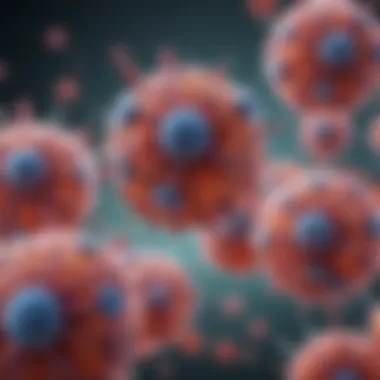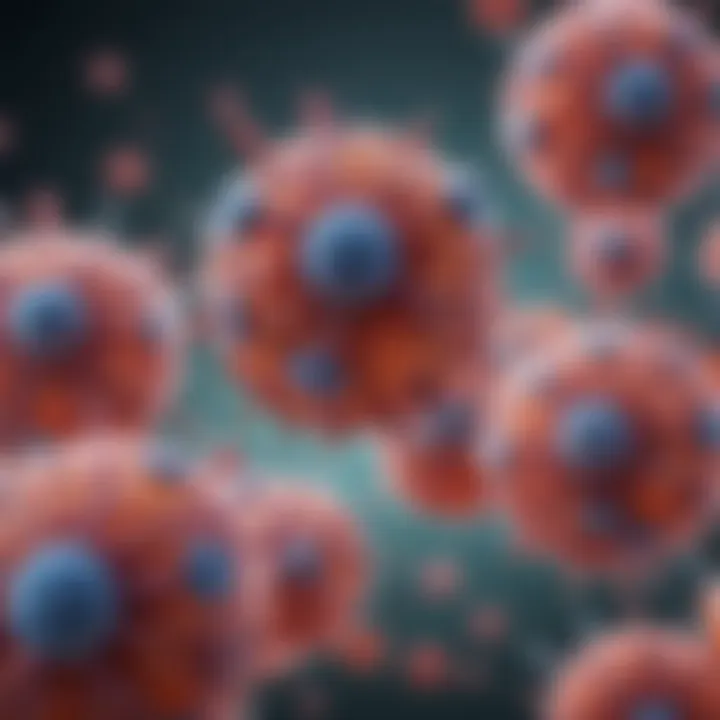Monoclonal Drugs: Transforming Modern Medicine


Intro
Monoclonal drugs have undoubtedly become monumental in modern medicine. These tailored therapies have opened new pathways in the treatment of various diseases, fundamentally altering how we approach illness, particularly in oncology and autoimmune disorders. Understanding their workings, applications, and the ongoing advancements in this arena is paramount, especially as healthcare continues its march towards personalized medicine.
This article digs deep into the essence of monoclonal drugs. We will explore their origins, mechanisms, and production, while keeping an eye on the burgeoning future that anticipates even more innovations. Through systematic analysis, we aim to demonstrate the critical role these drugs play in pushing the boundaries of therapeutic possibilities.
Recent Advances
Recent strides in monoclonal drug research have been nothing short of remarkable. As scientific endeavors pop up like mushrooms after rain, breakthroughs are reshaping our understanding and applications of these therapeutics, thus enhancing their reputation among healthcare professionals and patients alike.
Latest Discoveries
The latest discoveries in monoclonal antibodies showcase their effectiveness against not just cancers, but also diseases traditionally thought difficult to treat, such as Alzheimer's. Recent studies indicate that monoclonal drugs targeting beta-amyloid plaques could significantly slow down cognitive decline in affected individuals. In another exciting development, researchers have begun exploring how these drugs can modulate the immune response, establishing their potential in treating chronic inflammatory conditions. The ever-widening efficacy range paves the way for broadened therapeutic applications.
Technological Innovations
Stepping into the lab, the manner in which monoclonal antibodies are produced has seen substantial improvements thanks to technology. Techniques like recombinant DNA technology and hybridoma techniques have not just boosted production rates, but also enhanced the specificity of these drugs. Sophisticated techniques enable researchers to create highly targeted therapies that minimize side effects while maximizing treatment efficacy. Automation in production processes is enhancing consistency and reducing costs—essential factors in making these therapies accessible.
"The evolution of monoclonal antibodies represents a paradigm shift in the therapeutic landscape."
Methodology
To provide a thorough understanding of monoclonal drugs, it’s important to outline how research is conducted in this field.
Research Design
Most studies have adopted a systematic review design, providing a pathway to gather powerful insights from a wide range of sources. This design allows for the compilation of data across various studies, thereby establishing robust evidence that supports the efficacy of these drugs across multiple indications.
Data Collection Techniques
Data collection is often multi-faceted, utilizing clinical trials, surveys, and laboratory experiments. Patient-centric studies gather firsthand feedback on treatment responses, while laboratory experiments provide crucial insights into the pharmacodynamics and pharmacokinetics of monoclonal drugs. The fusion of clinical data with technological advancements is further enriching our understanding of how these therapies can be optimized.
The nuances of monoclonal drugs are indeed vast. By examining recent advances along with sound methodologies, one begins to see how these spectacular innovations are shaping the frontier of healthcare.
Prelude to Monoclonal Drugs
Monoclonal drugs, especially monoclonal antibodies, have emerged as a cornerstone in contemporary medical interventions. Their significance lies not just in their clinical efficacy but also in the innovative approaches they embody. These drugs present a golden opportunity to tailor treatments at a remarkably granular level, enhancing therapeutic outcomes across a spectrum of diseases. As we navigate this intricate landscape, it becomes apparent that understanding monoclonal drugs is fundamental to grasping the future of therapeutics in healthcare.
Defining Monoclonal Antibodies
Monoclonal antibodies are laboratory-made molecules that can mimic the immune system's ability to fight off harmful pathogens such as viruses. Unlike polyclonal antibodies, which are produced naturally and can bind to multiple parts of an antigen, monoclonal antibodies are crafted to bind to a specific target, often a protein on the surface of cells. This precision enables them to deliver targeted action, making them immensely powerful in treating diseases, particularly cancers and autoimmune disorders.
The creation of monoclonal antibodies involves fusing a specific type of immune cell, known as a B cell, with a cancer cell. The resulting hybrid cell, known as a hybridoma, is capable of infinite replication and the production of identical antibodies. This process ensures that the antibodies produced are uniform and consistent, embodying the 'monoclonal' aspect of the name.
Historical Context
The journey of monoclonal antibodies began in the 1970s, a pivotal decade in biomedical research. The landmark discovery by Georges Köhler and César Milstein in 1975 laid the groundwork for what would become a revolution in therapeutics. Before this breakthrough, the concept of specifically targeting disease-modifying agents was largely theoretical. Their work didn't just earn them a Nobel Prize but also opened the floodgates to a new era in medicine.
Since then, monoclonal antibodies have been employed to treat an array of diseases, including various kinds of cancers and autoimmune diseases. The first therapeutic monoclonal antibody, muromonab-CD3, was approved by the FDA in 1986. This ushered in a new realm of possibilities, as researchers and clinicians began to explore the vast potential of these drugs.
In the decades that followed, further advancements in biotechnology and recombinant DNA technology have facilitated the development of numerous monoclonal drugs currently on the market. As a result, their application now spans beyond just oncology to encompass infectious diseases, allergies, and even neurological disorders, showcasing the flexibility and promise inherent in these powerful therapeutics.
Understanding both the science and history around monoclonal drugs is critical. It grounds us not just in the facts but in the transformative journey these agents have undertaken, shaping the medical field into what it is today. As the field continues to evolve, the implications are vast and profound.
Mechanisms of Action
The mechanisms through which monoclonal drugs operate are critical to understanding their transformative role in therapeutics. These mechanisms encompass various biological interactions that can directly influence the course of diseases. A solid grasp of these nuances is vital for anyone delving into the realms of modern medicine and therapeutic development. By discerning how these drugs function, professionals can better appreciate their application across an array of clinical settings.
Binding and Specificity
When it comes to monoclonal antibodies, binding and specificity are the bedrock of their functionality. Each monoclonal antibody is engineered to target a unique antigen, often present on the surface of cells. This specificity is what sets them apart from traditional therapies, like broad-spectrum antibiotics.
The nuances of this binding can be illustrated through the example of trastuzumab, commonly known as Herceptin. It binds to the HER2 receptor, which is overexpressed in certain types of breast cancer. By locking onto this receptor, trastuzumab effectively inhibits the proliferation of cancer cells that would otherwise thrive. This ability to hone in on specific targets enables monoclonal drugs to minimize off-target effects and enhances their efficacy. Additionally, the strong binding affinity of these antibodies ensures that they remain attached to their target long enough to exert their therapeutic effect.
Key points about binding and specificity include:
- Targeted Action: Monoclonal drugs are designed to zero in on specific proteins or cells, reducing the collateral damage to healthy tissues.
- High Affinity: The interaction between an antibody and its antigen is characterized by high affinity, meaning they fit together like a lock and key, ensuring more effective treatment outcomes.
- Potential Resistance: While specificity can improve efficacy, there is also the risk of cancer cells developing mechanisms to evade detection, leading to treatment resistance.
Immune System Modulation
The immune system is both a warrior and a regulator in the body. Monoclonal drugs can modify the immune response significantly. This modulation can be harnessed to either bolster the body’s natural immune response against malignant cells or tamp down an overactive immune system in conditions like autoimmune diseases.
A prime example is the use of monoclonal antibodies in treating autoimmune disorders, such as rheumatoid arthritis. Drugs like adalimumab, or Humira, work by inhibiting a protein called tumor necrosis factor-alpha (TNF-alpha). This action decreases inflammation and prevents joint damage in affected patients. Similarly, monoclonal antibodies like pembrolizumab generate an enhanced immune response by blocking pathways that cancer cells exploit to evade immune detection.


Some considerations of immune system modulation are:
- Balance is Key: While enhancing immune responses can lead to successful outcomes in treating cancer, it may also induce autoimmunity. Therefore, understanding the right balance is crucial.
- Tailoring Treatments: The specific immune modulation achieved by different monoclonal drugs allows for personalized therapies, catering to the distinct needs of each patient.
- Research and Development: The field is continuously evolving, with ongoing research aimed at exploring new ways monoclonal antibodies can reshape immune responses for better therapeutic efficacy.
"Monoclonal drugs represent a leap forward, not only in how we treat existing conditions but also in understanding the underlying mechanisms of action. The more we know, the better we can adapt our approaches to healthcare."
In summary, understanding the mechanisms of action behind monoclonal drugs—encompassing their binding specificity and immune system modulation—provides crucial insight into their therapeutic potentials. With these tools, clinicians can navigate the challenging landscape of modern disease treatments effectively.
Production of Monoclonal Antibodies
The production of monoclonal antibodies represents a cornerstone in the advancement of therapeutic interventions. Understanding the processes behind their creation not only illuminates the significance of these drugs but also showcases the interplay of science, technology, and medicine. This section delves into three primary methods of monoclonal antibody production, exploring their intricacies and emphasizing the implications for both patient care and research.
Hybridoma Technology
Hybridoma technology remains a trailblazer in the quest for producing monoclonal antibodies. Developed by Georges Köhler and César Milstein in 1975, this method merges myeloma cells with antibody-producing B cells. The fusion creates hybrid cells, termed hybridomas, which can generate a specific antibody indefinitely.
The significance of hybridoma technology lies in its ability to produce large quantities of a single type of antibody. This is crucial for therapeutic efficacy, especially in treatments targeting cancers or autoimmune diseases. The process typically involves:
- Immunization: Mice are immunized with an antigen, prompting their immune systems to produce specific antibodies.
- Cell Fusion: B lymphocytes are merged with myeloma cells, creating hybridomas.
- Screening: Only hybridomas producing the desired antibody are selected for further growth and propagation.
Although it’s a powerful technique, hybridoma technology does have limitations. For instance, the process can be time-consuming and there may be challenges in achieving humanized antibodies suitable for clinical use. Nevertheless, it laid the foundational brickwork for the complex world of monoclonal antibody development.
Recombinant DNA Technology
In the era where precision is king, recombinant DNA technology has emerged as an innovative approach to monoclonal antibody production. This method utilizes genetic engineering to produce antibodies in vitro, thus allowing for more control over the resulting antibody characteristics. By incorporating genes encoding the desired antibody into suitable expression systems, researchers can produce monoclonal antibodies that are closer to human antibodies in structure and function.
Key processes in recombinant DNA technology include:
- Gene Isolation: Genes coding for the desired antibody are extracted from B cells.
- Cloning: These genes are then inserted into plasmids, which are used to transform host cells such as bacteria or yeast.
- Expression and Harvesting: The transformed cells are cultured, and the antibodies are harvested and purified.
Recombinant DNA technology presents several advantages. For starters, it often leads to a faster and more efficient production process. Additionally, it allows for the creation of customized antibodies tailored to specifically interact with certain antigens. Researchers can fine-tune properties like affinity and specificity, ultimately leading to better therapeutic outcomes.
Quality Control Measures
Producing monoclonal antibodies is one thing, but ensuring their safety and efficacy is another. Quality control measures play a critical role in the production process. They ensure that each batch of monoclonal antibody meets rigorous standards for purity, potency, and effectiveness. This aspect is non-negotiable in maintaining trust in the therapeutic use of monoclonal drugs.
Effective quality control utilizes a series of approaches, which may include:
- Characterization Tests: Assessing the structural and functional properties of the antibodies, confirming that they behave as expected in clinical contexts.
- Stability Studies: Evaluating how well the antibody remains effective over time under various storage conditions.
- Contaminant Testing: Ensuring the absence of microbial contamination and other foreign substances that could compromise safety.
As we step into a future where monoclonal antibodies could potentially treat a wider array of diseases, maintaining high standards through quality control is imperative. It serves as a safeguard, ensuring patient safety while also reinforcing confidence in these groundbreaking therapies.
"Quality in our products and processes is a non-negotiable principle that guides every step in the production of monoclonal antibodies."
In summary, the production of monoclonal antibodies, whether through hybridoma or recombinant DNA technologies, lays the groundwork for transforming therapeutic interventions. As advancements continue to emerge in production techniques and quality measures, the potential applications for age-old medical challenges simply expand.
Therapeutic Applications
The realm of monoclonal drugs is increasingly recognized for their role as therapeutic agents in multiple diseases. Understanding their applications is pivotal in grasping how they reshape treatment paradigms. Monoclonal antibodies allow for targeted therapy, which not only enhances efficacy but also reduces the likelihood of adverse effects associated with conventional treatments. Their versatility spans across fields like oncology, immunology, and infectious diseases, making them a crucial topic in modern medicine.
Cancer Treatments
Targeting Tumor Antigens
One of the cornerstones of therapeutic monoclonal antibodies lies in their ability to target tumor antigens. Cancer cells often present unique proteins or markers that distinguish them from normal cells. By home in on these antigens, monoclonal antibodies can selectively bind to tumors, effectively marking them for destruction by the immune system. This bridging of the immune response with cancer treatment presents a dual advantage: it not only destroys malignant cells but also spares healthy tissue.
A significant characteristic of targeting tumor antigens is its precision. The selectivity minimizes collateral damage – a common side-effect of traditional cancer therapies like chemotherapy, which can wipe out healthy cells alongside cancerous ones.
However, the unique feature of tumor antigens can also hold disadvantages. Not all tumors express the same antigens, leading to variability in treatment effectiveness across different cancers. This complexity requires a tailored approach, wherein ongoing research is essential to mapping out the distinct profiles of various tumors.
Monoclonal Antibodies in Immunotherapy
Immunotherapy has become synonymous with cutting-edge cancer treatment, and monoclonal antibodies play a vital role. These antibodies can either stimulate the immune system to attack cancer cells or inhibit certain pathways that allow cancers to evade immune detection. One key characteristic that sets these antibodies apart is their ability to modulate the immune response rather than simply target the disease.
As a beneficial choice in oncological care, the unique capability of monoclonal antibodies in immunotherapy helps to engage the body's defenses effectively. This becomes particularly valuable in conditions where tumors may be resistant to other forms of therapy. However, this targeted immune activation can also lead to adverse reactions, like cytokine release syndrome, which warrants careful patient monitoring.
Autoimmune Disorders
Mechanisms in Autoimmunity
In autoimmune disorders, the immune system mistakenly attacks the body's own tissues. Monoclonal antibodies that inhibit specific immune responses have become critical tools in managing these diseases. These therapies can target components involved in the inflammatory response, thus mitigating symptoms and preventing further damage.
The ability to target these mechanisms offers considerable benefits, notably reducing flare-ups and improving the quality of life for patients. Yet, one must acknowledge the ongoing debate about long-term implications, as these treatments can suppress the immune system, potentially leading to increased susceptibility to infections.
Case Studies


Insights from case studies underline the transformative potential of monoclonal drugs in autoimmune diseases. Observations from real-world therapies, like the use of Rituximab in rheumatoid arthritis, illustrate significant reductions in disease activity. Such distinct examples not only highlight the effectiveness but also bring to the fore considerations on the varying responses among individuals.
Moreover, case studies often illuminate the nuances in treatment efficacy, lending support to personalized medicine approaches. However, public awareness about the limitations and risks associated with long-term treatment with monoclonal antibodies is vital for informed decision-making.
Infectious Diseases
Monoclonal Antibodies for Viral Infections
As we turn to infectious diseases, monoclonal antibodies are gaining traction as therapeutic options, particularly for viral infections. These antibodies can neutralize viruses, preventing them from infecting healthy cells, which is particularly relevant in emerging diseases.
A standout characteristic of monoclonal antibodies in this ‘battle against viruses’ is their rapid effect on viral loads, providing immediate support where traditional antivirals may fall short in efficacy.
However, the development of monoclonal antibody treatments requires significant investment and time, often delaying access in urgent situations. This trend raises questions about how quickly we can adapt our therapeutic toolbox to meet new viral threats.
Ongoing Research in Infectious Disease
The world of ongoing research in monoclonal antibodies to combat infectious diseases remains vibrant and constantly evolving. Scientists are exploring various applications, from treating HIV to less common viral outbreaks. The fluidity of these studies underscores the need for continual innovation in therapeutic strategies.
A noteworthy characteristic of ongoing research is the collaboration between academia, industry, and governing bodies to streamline the path from laboratory discovery to clinical application. Yet, this endeavor is not without its challenges. Regulatory pathways can impede timely access to promising treatments, highlighting the need for an adaptive and proactive framework in drug development.
"Monoclonal antibodies are not just a treatment; they represent a paradigm shift in how we understand disease management across disciplines."
In summation, therapeutic applications of monoclonal drugs not only reveal their potential in treating various diseases but also bring to light the nuances of their effectiveness and limitations. This dynamic landscape beckons for extensive further research and continuous dialogue on ethical, clinical, and regulatory fronts.
Advantages of Monoclonal Drugs
The significance of monoclonal drugs in contemporary medicine cannot be underestimated. These tailored therapeutic agents offer a multitude of benefits that set them apart from conventional treatments. Their unique characteristics are tailored specifically for targeted interventions, which enhances treatment outcomes. This section delves into the pivotal advantages of monoclonal drugs, shedding light on their high specificity, consistent production, and the potential for personalization of therapies. Each of these aspects contributes not only to the efficacy of treatments but also to the overall improvement in patient care.
High Specificity
One of the standout features of monoclonal drugs is their high specificity. Unlike broad-spectrum therapies that may affect a variety of cells, monoclonal antibodies are designed to latch onto particular antigens on the surface of target cells. This precision means that the therapy can selectively target diseased cells, such as cancerous ones, while sparing healthy cells.
For instance, trastuzumab, often known by the brand name Herceptin, is used in treating breast cancer by specifically binding to the HER2 receptor, which is overexpressed in some breast cancers. By doing so, trastuzumab effectively inhibits the growth of these malignant cells without compromising normal tissues, which is a significant leap from older, less targeted cancer therapies. This high specificity not only improves efficacy but also reduces the side effects often associated with chemotherapy.
Consistent Production
The consistent production of monoclonal antibodies is another notable advantage. Monoclonal drugs are produced using methods like hybridoma technology, which allows for the creation of a homogeneous population of antibody-producing cells. This ensures that each batch of the drug is uniform, providing reliable therapeutic effects.
Moreover, the scalability of production is a key factor. As demand for these drugs increases, manufacturers can ramp up production without compromising the quality. This consistency means that clinicians can trust the results from these therapies. Patients are not left wondering if each dose represents the same reliability and effectiveness, ensuring a sense of stability in their treatment journey.
Potential for Personalization
The potential for personalization in therapy is what truly suggests a revolutionary change in how we approach various diseases, especially cancer and autoimmune disorders. Monoclonal antibodies can be engineered to fit the specific needs of individual patients. This customization allows for treatments that take into account not just the type of disease but also the unique biological makeup of the patient.
For example, ongoing research into biomarkers is paving the way for targeted therapies based on a patient's genetic profile or specific disease characteristics. This means that patients could potentially receive monoclonal therapeutics that are uniquely suited to their own biology. It’s a paradigm where the traditional one-size-fits-all approach is being replaced by more tailored interventions that consider the complexity of human health.
"The future of medicine lies not in a blanket approach, but in understanding the individual intricacies of each patient's condition. Monoclonal drugs exemplify this shift toward personalized care."
In summary, the advantages of monoclonal drugs extend far beyond mere effectiveness. They offer high specificity, ensuring targeted action with fewer side effects; consistent production, guaranteeing dependable therapeutic outcomes; and the potential for personalization, which aligns treatment strategies with individual patient needs. These traits position monoclonal drugs at the forefront of therapeutic innovation, promising a future in medicine that is as precise as it is powerful.
Challenges and Limitations
Despite the promise that monoclonal drugs present in modern medicine, various challenges persist that can affect their widespread utilization and effectiveness. An understanding of these limitations is crucial for patients, healthcare professionals, researchers, and regulatory bodies alike. Addressing these concerns can lead to optimal therapeutic outcomes, ensuring that monoclonal drugs fulfill their potential in treating complex diseases.
Cost of Production
One of the most significant hurdles in the field of monoclonal drug development is the cost of production. The price tag associated with manufacturing these drugs is often staggering, driven by the intricate processes involved in their creation.
- The hybridoma technology utilized in antibody production requires specialized facilities and skilled personnel. This translates into high operational costs.
- Moreover, recombinant DNA technology demands advanced biotechnological methods, which also increases the overall expenditure.
- Quality control is paramount to ensure the safety and efficacy of monoclonal drugs, adding another layer of expense to the production process.
Due to these high costs, many pharmaceutical companies may hesitate to invest in monoclonal drug research and development, particularly when weighed against potential market returns. Consequently, this may limit access to these promising therapies for those who need them.
Immunogenicity and Adverse Reactions
Immunogenicity—the ability of a substance to provoke an immune response—poses another challenge for monoclonal therapies. Certain patients may experience adverse reactions that can undermine the effectiveness of treatment or lead to harmful health consequences.
- Patients might develop anti-drug antibodies, which can neutralize the therapeutic effect or even prompt unwanted immune responses. This can complicate treatment regimens and potentially result in treatment failure.
- Adverse reactions like infusion-related reactions can occur, manifesting in symptoms ranging from fever to potentially severe anaphylaxis. Monitoring and managing these reactions adds complexity to patient care.
The variability in individual patient responses highlights the importance of personalized medicine approaches to mitigate these risks. Identifying predictive biomarkers could prove valuable in tailoring treatments to individual profiles, improving safety and efficacy.
Regulatory Hurdles
Navigating the regulatory landscape for monoclonal drugs can be daunting. Regulatory agencies prioritize patient safety and efficacy, leading to rigorous evaluation processes that can be time-consuming and expensive.


- The FDA and EMA have strict guidelines for clinical trials, requiring comprehensive data on efficacy, safety, and manufacturing processes before greenlighting new therapies.
- These requirements can lead to lengthy approval timelines, delaying patient access to potentially life-saving treatments.
Regulatory hurdles can also complicate the introduction of novel indications for existing monoclonal drugs. Thus, the process not only impacts timeline but also dictates the strategic planning of pharmaceutical companies as they decide which projects to pursue.
Future Directions in Monoclonal Therapy
As the landscape of medical treatment evolves, the future of monoclonal therapy holds transformative potential. With advancements in technology and a growing understanding of diseases, researchers and healthcare professionals are shifting their focus towards innovative strategies. These emerging directions in monoclonal therapy not only aim to enhance effectiveness but also address some of the pressing challenges faced in therapeutic applications.
Engineering Next-Generation Antibodies
The core of monoclonal therapies is the antibodies themselves. Thus, engineering next-generation antibodies represents a pivotal area of research. What does this involve? Scientists are increasingly utilizing genetic engineering techniques to enhance the properties of antibodies. This means creating antibodies that are more potent, specific, and capable of overcoming existing limitations.
Consider the example of bispecific antibodies. Unlike traditional monoclonal antibodies, which target a single antigen, bispecific antibodies can bind to two different targets simultaneously. This versatility has the potential to revolutionize treatments for conditions such as cancer and autoimmunity. Imagine a therapeutic agent that could direct an immune response towards a cancer cell while simultaneously inhibiting signals that allow the tumor to evade immune detection. This approach may significantly improve the efficacy of treatment regimens.
Moreover, affinity maturation is another engineering approach that researchers are investigating. This process enhances the strength of antibody binding, enabling treatment to become more effective at lower doses. As a result, patients may experience fewer side effects while receiving optimal therapeutic outcomes.
Combination Therapies
Monoclonal drugs are powerful on their own, but combination therapies represent a strategic direction in maximizing their impact. Using multiple therapeutic agents can yield synergistic effects, helping to overcome drug resistance which often complicates treatment for diseases like cancer.
One notable facet of combination therapy is the coupling of monoclonal antibodies with chemotherapy or targeted small-molecule drugs. By integrating these modalities, therapeutic regimens can be designed to attack tumors more aggressively. Consider the approach of combining a checkpoint inhibitor with an antibody that targets tumor-associated antigens. This could potentially enhance the immune response while directly targeting tumor cells.
Additionally, combinations can extend beyond traditional oncology. For autoimmune diseases, pairing monoclonal antibodies with immunomodulators may lead to more favorable results by sustaining treatment efficacy while minimizing adverse reactions.
Exploring New Targets
The scope of monoclonal therapy encompasses a vast array of diseases, and exploring new targets is crucial for future advancements. Target identification is essential in the quest for effective treatments, particularly for diseases with high unmet medical needs.
Researchers are now turning their attention toward personalized medicine, which emphasizes tailoring treatments to individual patient profiles. This involves studying specific biomarkers and molecular characteristics of diseases. For instance, in hematological malignancies, understanding the unique genetic makeup of a patient’s tumor could enable the design of monoclonal antibodies that target novel antigens.
Moreover, the realm of infectious diseases offers promising avenues. The development of monoclonal antibodies against emerging pathogens can play a critical role in outbreak responses, as seen during the COVID-19 pandemic.
The potential to identify and target new disease-causing mechanisms not only aids in enhancing therapeutic specificity but also taps into deep reservoirs of knowledge waiting to be uncovered within clinical research.
"As we advance, intentional exploration in monoclonal therapy sets precedents for innovative and effective treatments that align with the complexities of individual patient needs and emerging health challenges."
To sum up, the future directions in monoclonal therapy are vast and ripe with potential. With engineering of next-generation antibodies, strategic combination therapies, and the pursuit of new targets, the future holds promise for enhanced therapeutic strategies that have the potential to revolutionize treatment across many disease categories.
Ethical Considerations
In the realm of medicine, especially when talking about innovations like monoclonal drugs, the question of ethics is never far behind. These considerations come into play at various levels—ranging from access to treatment to the moral implications of how these therapies are developed and tested. It’s essential to dig into these aspects to ensure the advancements in therapeutics align with the core values of equity and humanity.
Access to Treatments
One of the most significant ethical dilemmas surrounding monoclonal drugs is access. As these therapies often carry hefty price tags, a divide exists between those who can afford them and those who cannot. The high costs can lead to a situation where effective treatments are available only to the privileged few, which poses a serious challenge to equity in healthcare.
Imagine a patient diagnosed with cancer. The doctor prescribes a monoclonal antibody treatment that promises a higher chance of recovery. However, the skyrocketing costs mean that this patient may face insurmountable financial barriers.
- Disparities in Healthcare: Access varies not just on an individual level but also across different regions and countries. Patients in low-income countries may not have the same access to these cutting-edge therapies, making the global health landscape increasingly skewed.
- Insurance Coverage: In many scenarios, insurance companies may not cover monoclonal drugs completely, leaving patients to navigate a minefield of unexpected expenses.
To address these concerns, healthcare providers and policymakers must collaborate to devise equitable distribution models. Ensuring that all patients have genuine access to lifesaving treatments could pave the way for a more just healthcare system.
Animal Testing and Alternatives
The ethical considerations surrounding animal testing are steeped in ongoing debate. Monoclonal drugs, like many pharmaceutical developments, often rely on animal studies to determine safety and efficacy. Critics argue that this practice raises serious humanitarian concerns.
Many question if it is justifiable to sacrifice animal lives for human benefit. Additionally, the relevance of animal testing to human biology is frequently cited as a contentious point. Here are some key points to mull over:
- Questionable Predictions: Scientific literature indicates that animal models do not always reliably predict human outcomes. This can lead to scenarios where drugs that show promise in animals fail in human trials, raising questions about the efficacy of such testing methods.
- Emerging Alternatives: Regarding alternatives, advancements in technology present new pathways. Organ-on-a-chip technologies and computer modeling can potentially reduce the reliance on animal subjects for effectiveness and safety studies.
While the path to cruelty-free research is fraught with complexity, pursuing alternatives is not just ethical but could lead to more accurate results in drug development. The conversation must continue to prioritize humane considerations while also seeking to maintain the effectiveness of therapeutic discoveries.
"Ethics isn't just about right or wrong; it's about how we, as a society, choose to value life, whether human or animal, in our relentless pursuit of progress."
Culmination
As we draw this exploration into the realm of monoclonal drugs to a close, it is vital to reflect on the key elements discussed throughout the article. The advancements brought forth by these drugs signify a monumental leap in therapeutic practices, reshaping the landscape of modern medicine. Monoclonal antibodies stand out not only for their precision in targeting disease but also for their ability to be adapted and engineered to meet specific patient needs. This customization lays the groundwork for tailored healthcare solutions, which significantly enhances patient outcomes while minimizing adverse effects that are common in broad-spectrum treatments.
Summary of Key Insights
- Precision Medicine: Monoclonal drugs exhibit extremely high specificity, making them effective at targeting particular antigens, which is crucial in conditions like cancer and autoimmune disorders.
- Production: The hybridoma technology and recombinant DNA techniques have made it possible to produce these antibodies at scale with consistent quality. This consistency is essential for achieving reliable therapeutic effects.
- Challenges: The journey isn’t free of hurdles. High production costs, potential immune system reactions, and the stringent regulatory landscape require ongoing attention and innovation.
- Future Prospects: The trajectory of monoclonal therapies is poised for growth. Engineering next-generation antibodies and exploring novel targets can further enhance their applicability and efficacy in treating a broader array of diseases.
"The future of monoclonal drugs holds the promise not only of improved treatments but also a more profound understanding of the immune system's capabilities."
The Road Ahead for Monoclonal Drugs
Looking forward, we find ourselves at the brink of significant advancements in monoclonal drug therapies. As research steadily uncovers new pathways and mechanisms of action, clinicians and researchers alike are encouraged to think outside the box. Several important elements will shape the future of these transformative therapies:
- Innovative Engineering: The next generation of monoclonal antibodies aims to overcome the limitations faced by existing drugs. This includes enhancing their half-life in the body, reducing immunogenic responses, and achieving greater effectiveness against complex diseases.
- Combination Therapies: As we venture further, combining monoclonal antibodies with other treatment modalities, such as checkpoint inhibitors or targeted therapies, promises to augment their effectiveness. This synergistic approach might lead to more profound remissions in diseases that were previously considered difficult to treat.
- Ongoing Research: Continuous investigation into new biomarkers and therapeutic targets is vital. The unfolding science around the immune system's nuances will take center stage, driving the research agenda and ultimately widening the therapeutic scope of monoclonal drugs.
In sum, monoclonal therapies are not a mere transient trend; they promise to inch closer to a new era of treatment that emphasizes both efficacy and patient well-being. The emphasis on scientific inquiry and sensible development dictates that the future of monoclonal drugs could very well redefine the limits of what's achievable in medicine.















